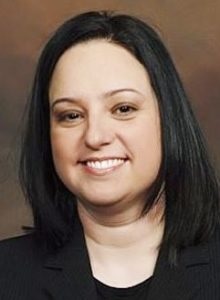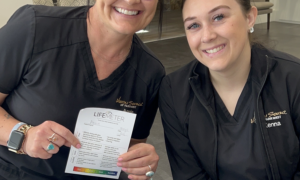By Maria Sampalis, OD

July 31, 2019
I always am looking for ways to improve the patient experience and become more profitable. One of the ways I do that is by performing a SWOT analysis of the practice at least once a year. This systematic survey of my practice allows me to ensure patients are being served to the best of our ability, and that we are as efficient and profitable as possible.
“SWOT” is an acronym that stands for strengths, weaknesses, opportunities and threats.
Strengths
I’ve found that my strengths relate to the more-than-a-decade I have been practicing in my community of Warwick, R.I., and the level of trust and rapport I have built with patients over that time. I am familiar with most of my patients’ families, including how many children they have, how the parents spend their work lives, the grades in school the children are in and the extracurricular activities those children participate in.
Practice Profile
Number of locations: 2
Number of ODs: 1
Number of support staff (non-ODs) 2
Number of annual exams performed across all locations and all doctors: 3,000
This is a strength because this familiarity creates a bond between my patients and I that encourages them to come back to the practice every year. This knowledge also is a strength because it allows me to prescribe the services and products my patients most need, such as computer eyewear with blue-light-blocking lenses for those who spend long hours in an office every week day, driving sunwear for those with long commutes on the roads and specialized sports sunwear for patients with a passion for activities like golf, boating or hunting.
You can use your practice metrics to discover your strengths. In our case, it meant noticing the number of long-term, returning patients and the quality of the feedback we get from patients in online reviews and in face-to-face communications in our office, along with the high rate of friends and family referrals. It is clear that we are a trusted health-care practice that patients feel confident returning to annually, and referring others to experience.
Weaknesses
A challenge for us is office space. Ideally, it would be helpful to have additional exam and pre-testing space, so more patients could be seen per day. However, I have crunched the numbers, and at this point, it only makes sense for us to have the two exam rooms that we currently have. The key is finding ways maximize the patient experience and efficiency in the space that we already have before looking into adding more space.
Other Articles to Explore
That has meant finding the balance between having the time for conversation with patients and keeping the patient flow moving. I like to spend 10-15 minutes with each patient in the exam room. In my mind, I have a checklist of most-important points to cover with the patient. That way, I know that after a few minutes of small talk in which we catch up on personal-life happenings, I should ask about eyecare needs that did not naturally come up in the casual conversation.
I might segue a conversation about the children’s recent participation in a school play: “That’s great that Jennifer is participating in more after-school activities! I know how hard it can be to get a shy child to put themselves out there like that. Are there any other activities she is trying? I remember you mentioning that she was thinking of gymnastics last year. Do you think it might be beneficial to have her try daily disposable contact lenses? I think she’s old enough, and responsible enough, to safely wear contacts now, and she might enjoy the freedom from glasses when on stage or on the balance beam.”
Opportunities
Weaknesses and opportunities can go hand-in-hand. A lack of office space and a need for high-quality, yet efficient, care, can mean a need for advanced technology. The right cutting-edge instrumentation can speed up the exam process, enhance care by finding conditions at early stages and generate revenues.
For example, I found that the addition of a retinal camera does all of those things. In my last office space, which was even smaller than what I have now, I leased a retinal camera.
It was $20,000, with a payment of $450 per month, which I paid off in two-and-a-half years.
The reimbursement for use of the camera is $90, so all I needed was five patients per month to pay the $450 monthly payment. I could have paid off the lease earlier than the two-and-a-half years I took to do so, but I wanted to keep money free for other practice investments.
The potential for generating revenues from use of the retinal camera is substantial. If you have at least 10 patients per week that you are using the retinal camera for, and you are open 50 weeks per year, you will generate $45,000-$50,000 annually. I estimate that we generate $50,000-$60,000 annually from use of the retinal camera.
Threats
Great threats to independent optometry include competition from online retail and big-box, chain optical stores, along with lower reimbursements from managed-care plans and disruptive technology, such as the technology that has enabled online refractions. In addition, some practice owners, like myself, see private equity as a threat to independent ownership.
The first way I combat external threats from other independent ODs and optical retailers is by communicating the value of my services to patients. During exams, I explain to patients what I am doing, and how each part of the exam safeguards their eye health. I might note the added risk a patient is at, based on family history, for glaucoma or macular degeneration, and then explain how the findings of the exam each year enable me to assess the risk, or progression of the disease (if it has already been diagnosed) and whether other treatment services are needed.
Value is Best Defense Against Threats
I also focus on enhancing marketing. During the summer, for instance, I make the most of patients’ heightened awareness of the sun to educate on the many ways I can help them protect their eyes from ultra-violet radiation, from adding Transitions lenses to their glasses to the array of sunwear we offer, including polarized options that eliminate glare.
In addition, I send e-blasts to patients reminding them that kids will be going back to school before they know it, and that it’s the perfect time to come in for an annual exam to ensure students get a good start to the school year.
Networking with other health-care practitioners in my community through state optometric meetings, and at events like community health fairs, also has been important to my practice growth. I meet the doctors with whom I can build mutually beneficial relationships. They learn who I am, and how my expertise and services help patients.
 Maria Sampalis, OD, practices at Sampalis Eye Care in Warwick RI. She is also the founder of Corporate Optometry on Facebook. Dr. Sampalis is also founder of the new job site corporateoptometrycareers.com and www.corporateoptometry.com. She is available for practice management consulting. To contact: msampalis@hotmail.com
Maria Sampalis, OD, practices at Sampalis Eye Care in Warwick RI. She is also the founder of Corporate Optometry on Facebook. Dr. Sampalis is also founder of the new job site corporateoptometrycareers.com and www.corporateoptometry.com. She is available for practice management consulting. To contact: msampalis@hotmail.com



























